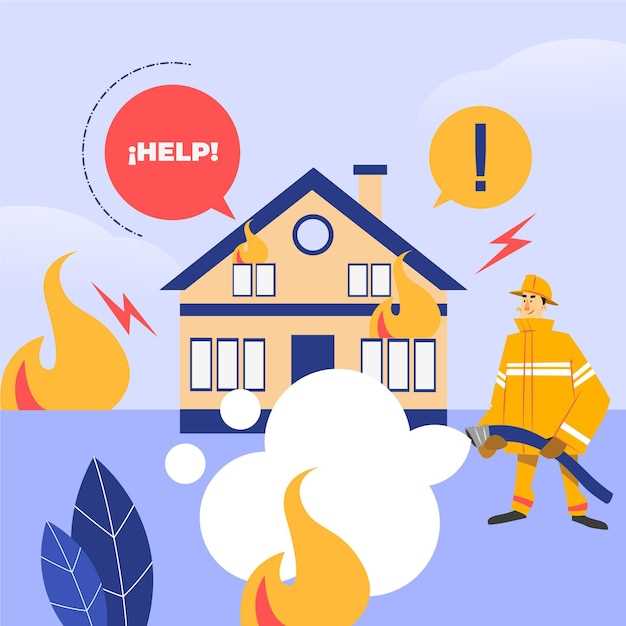
As a proprietor, it is imperative to prioritize the protection and well-being of your commercial establishment. In today’s fast-paced world, where unforeseen incidents can occur at any moment, it is crucial to implement effective strategies to safeguard your property and its occupants. This article aims to provide you with a comprehensive guide on the essential precautions you can take to ensure the security of your business premises.
Creating a Secure Environment: Establishing a safe and secure environment is the foundation of any fire prevention plan. This involves implementing robust security measures, such as installing state-of-the-art surveillance systems, access control systems, and alarm systems. By investing in these advanced technologies, you can effectively deter potential threats and promptly respond to any emergencies that may arise.
Regular Inspections and Maintenance: Regular inspections and maintenance are vital to identify potential fire hazards and ensure the proper functioning of fire safety equipment. This includes checking fire extinguishers, smoke detectors, sprinkler systems, and emergency exits. By conducting routine inspections, you can address any issues promptly and minimize the risk of fire incidents.
Employee Training and Awareness: Your employees play a crucial role in maintaining fire safety within your commercial property. It is essential to provide comprehensive training programs that educate your staff on fire prevention techniques, evacuation procedures, and the proper use of fire safety equipment. By fostering a culture of awareness and preparedness, you can empower your employees to respond effectively in the event of a fire emergency.
Understanding Fire Safety Regulations and Compliance

In the realm of ensuring the protection and well-being of individuals and properties, it is imperative for commercial property owners to have a comprehensive understanding of fire safety regulations and compliance. By adhering to these guidelines, property owners can mitigate the risks associated with fire incidents and create a secure environment for all stakeholders.
Comprehending Fire Safety Regulations
Fire safety regulations encompass a set of rules and standards established by regulatory bodies to prevent, detect, and respond to fire emergencies effectively. These regulations outline the necessary measures and protocols that commercial property owners must implement to minimize the potential for fire outbreaks and ensure the safety of occupants.
Understanding the specific fire safety regulations applicable to a particular jurisdiction is crucial for commercial property owners. These regulations may encompass various aspects, including building construction requirements, installation and maintenance of fire detection and suppression systems, evacuation procedures, and training programs for employees.
Ensuring Compliance with Fire Safety Regulations
Compliance with fire safety regulations is not only a legal obligation but also a moral responsibility for commercial property owners. By adhering to these regulations, property owners demonstrate their commitment to safeguarding lives and assets from the devastating consequences of fire incidents.
Ensuring compliance involves conducting regular fire risk assessments to identify potential hazards and vulnerabilities within the property. This assessment helps property owners develop and implement appropriate fire safety measures, such as installing fire alarms, extinguishers, and sprinkler systems, as well as establishing clear evacuation routes and conducting regular drills.
Additionally, property owners must stay updated with any changes or amendments to fire safety regulations and promptly incorporate them into their existing fire safety plans. Regular inspections and maintenance of fire safety equipment are also essential to ensure their proper functioning and compliance with regulations.
In conclusion, understanding fire safety regulations and compliance is paramount for commercial property owners. By comprehending the regulations and ensuring compliance, property owners can create a secure environment that prioritizes the safety and well-being of all individuals within the premises.
Implementing Fire Detection and Alarm Systems
Incorporating effective fire detection and alarm systems is a crucial aspect of ensuring the safety and security of commercial properties. By implementing these systems, property owners can proactively detect and alert occupants about potential fire hazards, allowing for timely evacuation and minimizing the risk of injuries or fatalities.
Installing state-of-the-art fire detection systems is essential for commercial property owners to promptly identify any signs of fire. These systems utilize advanced technologies such as smoke detectors, heat sensors, and flame detectors to detect the presence of fire or smoke. By continuously monitoring the environment, these systems can quickly raise an alarm, enabling swift action to be taken to mitigate the fire’s impact.
Integrating fire alarm systems with emergency communication systems is another crucial step in ensuring the effectiveness of fire safety measures. By connecting fire alarm systems with public address systems or emergency notification systems, property owners can efficiently communicate evacuation instructions to occupants in a clear and timely manner. This integration enhances the overall emergency response and helps prevent panic or confusion during fire incidents.
Regular maintenance and testing of fire detection and alarm systems are imperative to ensure their reliability and functionality. Property owners should establish a comprehensive maintenance schedule, including regular inspections, testing, and servicing of the systems. This proactive approach helps identify any potential issues or malfunctions, allowing for timely repairs or replacements to be carried out, thus minimizing the risk of system failure during an actual fire event.
Training occupants on fire safety procedures is equally important in maximizing the effectiveness of fire detection and alarm systems. Property owners should conduct regular fire drills and provide training sessions to educate occupants on evacuation routes, assembly points, and proper use of fire safety equipment. This knowledge empowers occupants to respond swiftly and appropriately in the event of a fire, ensuring their safety and minimizing property damage.
Collaborating with fire safety professionals is highly recommended for commercial property owners to ensure the proper implementation and maintenance of fire detection and alarm systems. Consulting with experts in the field can help property owners identify the most suitable systems for their specific needs, comply with relevant fire safety regulations, and stay updated on the latest advancements in fire safety technology.
In conclusion, implementing fire detection and alarm systems is a critical component of comprehensive fire safety measures for commercial properties. By incorporating advanced technology, integrating with emergency communication systems, conducting regular maintenance, providing occupant training, and seeking professional guidance, property owners can significantly enhance the overall fire safety of their premises.
Ensuring Adequate Fire Extinguishing Equipment
When it comes to safeguarding your commercial property, it is crucial to prioritize the presence of effective fire extinguishing equipment. The ability to promptly and efficiently extinguish fires can significantly minimize potential damages and ensure the safety of occupants and valuable assets.
Choosing the Right Fire Extinguishers
One of the key aspects of ensuring adequate fire extinguishing equipment is selecting the right type of fire extinguishers for your specific needs. Different types of fires require different extinguishing agents, such as water, foam, dry chemical, or carbon dioxide. It is essential to assess the potential fire hazards in your property and choose extinguishers that are suitable for combating those specific types of fires.
Regular Maintenance and Inspection
Equally important is the regular maintenance and inspection of fire extinguishing equipment. It is crucial to establish a comprehensive maintenance schedule to ensure that all extinguishers are in proper working condition. This includes checking the pressure levels, inspecting for any physical damages or signs of corrosion, and verifying that the extinguishers are easily accessible and properly mounted.
Proper Training and Education
In addition to having the right fire extinguishing equipment, it is vital to provide proper training and education to your staff or occupants. Ensuring that they are familiar with the location and proper usage of fire extinguishers can make a significant difference in effectively responding to a fire emergency. Conducting regular fire drills and providing training sessions on fire safety procedures can help instill a sense of preparedness and ensure everyone knows how to use the extinguishing equipment correctly.
In conclusion, ensuring adequate fire extinguishing equipment is a critical aspect of fire safety for commercial property owners. By choosing the right extinguishers, conducting regular maintenance and inspections, and providing proper training, you can enhance the overall fire safety measures in your property and protect both lives and assets.
Creating and Maintaining Fire Escape Routes
Ensuring the safety of occupants in commercial properties requires careful planning and implementation of effective fire escape routes. These routes serve as crucial pathways for individuals to evacuate the premises in the event of a fire emergency. In this section, we will explore the essential steps involved in creating and maintaining these vital escape routes.
1. Establishing Clear Pathways:
- Designating primary and secondary escape routes to provide multiple options for evacuation.
- Ensuring that escape routes are clearly marked and easily identifiable, using signage and floor plans.
- Regularly inspecting and removing any obstacles or obstructions that may hinder the flow of evacuation.
2. Adequate Lighting and Signage:
- Installing and maintaining proper lighting along escape routes to ensure visibility, even in low-light conditions.
- Using illuminated exit signs and directional arrows to guide occupants towards the nearest exit.
- Regularly testing and replacing emergency lighting systems to ensure their functionality.
3. Fire Doors and Exits:
- Installing fire-resistant doors along escape routes to prevent the spread of fire and smoke.
- Regularly inspecting and maintaining fire doors to ensure their proper functioning.
- Keeping exits clear of any obstructions, such as storage items or debris.
4. Emergency Exit Routes:
- Designating specific emergency exit routes for individuals with disabilities or mobility limitations.
- Ensuring that these routes are easily accessible and equipped with appropriate aids, such as ramps or handrails.
- Regularly reviewing and updating emergency exit plans to accommodate any changes in the property layout or occupancy.
5. Staff Training and Education:
- Providing comprehensive fire safety training to all employees, including information on escape routes and evacuation procedures.
- Conducting regular drills and simulations to familiarize occupants with the designated escape routes.
- Ensuring that staff members are aware of their roles and responsibilities during a fire emergency.
By diligently creating and maintaining fire escape routes, commercial property owners can significantly enhance the safety of their occupants and minimize the potential risks associated with fire incidents. Regular inspections, proper signage, and staff training are essential components of an effective fire safety plan.
Training Employees in Fire Safety Procedures
Equipping your workforce with the knowledge and skills to effectively respond to fire emergencies is crucial for the overall safety and well-being of your commercial establishment. Ensuring that your employees are well-trained in fire safety procedures can significantly reduce the risk of fire-related incidents and minimize potential damage.
Empowering your staff with the necessary expertise to handle fire emergencies not only enhances their preparedness but also instills a sense of confidence and responsibility in them. By providing comprehensive training, you enable your employees to identify potential fire hazards, understand the proper use of firefighting equipment, and execute evacuation procedures efficiently.
Effective fire safety training should cover a range of topics, including fire prevention measures, emergency evacuation protocols, and first aid techniques. It is essential to tailor the training to the specific needs of your commercial property, taking into account its unique layout, occupancy, and potential fire risks.
During the training sessions, it is crucial to emphasize the importance of vigilance and proactive measures in preventing fires. Employees should be educated on the significance of promptly reporting any fire hazards or potential risks they come across, as well as the appropriate actions to take in case of a fire outbreak.
Furthermore, incorporating practical exercises and hands-on demonstrations can greatly enhance the effectiveness of the training. This allows employees to gain practical experience in using fire extinguishers, evacuating safely, and administering basic first aid, thereby boosting their competence and confidence in handling fire emergencies.
In conclusion, investing in comprehensive fire safety training for your employees is a vital aspect of maintaining a secure commercial property. By equipping your workforce with the necessary knowledge and skills, you can significantly reduce the risk of fire incidents and ensure the safety of both your employees and your property.
Regular Fire Safety Inspections and Maintenance
Ensuring the ongoing safety of your commercial property requires regular inspections and maintenance to prevent and mitigate the risks associated with fire incidents. By conducting routine assessments and implementing necessary measures, property owners can significantly reduce the likelihood of fire-related accidents and protect the well-being of occupants and assets.
Regular fire safety inspections involve a comprehensive evaluation of the property’s fire prevention systems, including fire alarms, sprinkler systems, fire extinguishers, and emergency exits. These inspections aim to identify any potential issues or deficiencies that may compromise the effectiveness of these safety measures. By addressing these concerns promptly, property owners can ensure that their fire prevention systems are functioning optimally and are ready to respond in case of an emergency.
In addition to inspections, regular maintenance is crucial to keep fire safety measures in optimal condition. This includes regular testing and servicing of fire alarms and sprinkler systems to ensure their proper functioning. Fire extinguishers should be inspected and maintained according to the manufacturer’s guidelines, with regular checks for pressure levels and expiration dates. Emergency exits should be regularly inspected to ensure they are unobstructed and easily accessible in case of an evacuation.
Property owners should also establish a clear maintenance schedule and keep detailed records of all inspections and maintenance activities. This documentation serves as evidence of compliance with fire safety regulations and can be invaluable in case of an audit or investigation. It is essential to prioritize regular inspections and maintenance as part of a proactive approach to fire safety, rather than waiting for issues to arise before taking action.
- Conduct routine assessments of fire prevention systems
- Address any identified issues or deficiencies promptly
- Test and service fire alarms and sprinkler systems regularly
- Inspect and maintain fire extinguishers according to guidelines
- Ensure emergency exits are unobstructed and accessible
- Establish a clear maintenance schedule and keep detailed records
By prioritizing regular fire safety inspections and maintenance, commercial property owners can create a safer environment for occupants and minimize the potential damage and loss caused by fire incidents.



